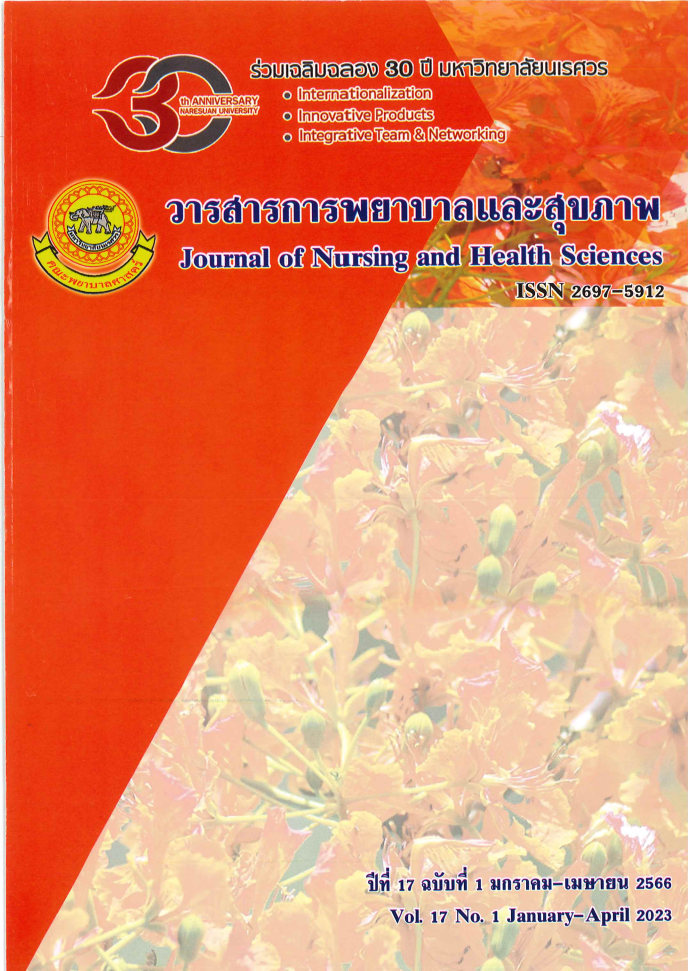The Study of Needs and Factors Explaining for Participatory to Create Well-Being Based on New Normal Life of the Older Adult among Urban Community, Ratchaburi Province.
Main Article Content
Abstract
This mixed method research was to study the needs assessment, the level of participation and factors explaining for participatory to create well-being based on new normal life for older adult among urban community, Ratchaburi province.The sample of quantitative data were 421 older adults and qualitative data were 35 person.The research instrument consisted of need assessment questionnaire, semi-structured interview and focus group form that content validity between 0.66 - 1.00 and reliability of subscales for questionnaire were 0.83 and 0.87 respectively. The data were then analyzed using descriptive statistics such as percentage, mean, standard deviation, the priority needs index analysis and content analysis. The results revealed that needs must urgently develop the participation in religious activities/festivals (PNIModified= 0.59) and the receiving welfare and benefits (PNIModified = 0.56). The factors explaining for participatory to create well-being based on new normal life were community leadership, health literacy, social support and building collaboration network.
Therefore, the approaches to promote participation in creating well-being based on new normal life for older adult that should be consider needs and focus on promote community leadership, health literacy, social support and building collaboration network. In order to community strengthen and be able to take care of the older adult according to the well-being guidelines based on new normal life sustainably.
Article Details

This work is licensed under a Creative Commons Attribution-NonCommercial-NoDerivatives 4.0 International License.
References
Bass, B. M., & Avolio, B. J. (1994). Transformational leadership and organizational culture. The International Journal of
Public Administration, 17(3), 541-554.
Booranaklas W. (2017). Correlation between self-care behaviors, family relationship, and happiness of the elderly at the
community Saimai destrict in Bangkok Metropolitan. JOPN, 9(2), 25-33. [In Thai].
Cohen, J. M., & Uphoff, N. T. (1980). Participation's place in rural development: Seeking clarity through specificity. World
development, 8(3), 213-235.
Corday, D. (1990). An assessment from the policy perspective. In K. Wachter, & M. Strat, The future of meta-analysis.
New York: Sage.
Department of older persons. (2021). Statistics of the older adult in Thailand 77 provinces. Retrieved 10 October 2022 from
http:// www.dop.go.th/th/know/side/1/1/1099 [In Thai].
Fivecoat, H.C., Sayers, S.L., & Riegel, B. (2018). Social support predicts self-care confidence in patients with heart failure.
Eur J Cardiovasc Nurs, 17(7), 598-604.
Gaber, J. (2000). Meta-needs assessment. Evaluation and program planning, 23(2), 139-147.
Health Data Center .(2022). The report of population classified by gender and age yearly 2022 in Mueang District,
Ratchaburi Province, Regional health 5. Retrieved from https://hdcservice.moph.go.th/hdc/reports/report.php?source=formated/pop_sex_age.ph
p&cat_id=ac4eed1bddb23d6130746d62d2538fd0&id=710884bc8d16f755073cf194970b064a
House, J.S. (1981). Work stress and social support. California: Addison–Wesley.
Jirarattanawanna, N., Wattanaamorn, S., & Ratsamepong, S. (2019). Community participation in health promotion.
Mahachula Academic Journal, 6(special issue), 365-381. (in Thai)
MacLeod, S., Musich, S., Hawkins, K., Alsgaard, K., & Wicker, E. R. (2016). The impact of resilience among older
adults. Geriatric Nursing, 37(4), 266-272.
McNeish, R., & Tran, Q. (2020). Leadership that promotes successful implementation of community based mental health
interventions. Journal of Community Psychology, 48(5), 1500-1511. https://doi.org/10.1002/jcop.22343
Muensaen, N. & Kraiphibul, S. (2014). Community participation for health promotion of the elderly in Thungluke Village,
Chiang Dao District, Chiang Mai Province. Nursing Journal Volume, 41(1), 1-12. [In Thai].
Nutbeam D. (2015). Defining, measuring and improving health literacy. Health evaluation and promotion, 42(4), 450-456.
Peltomaki, P., & Husman, K. (2002). Networking between occupational health services, client enterprises and other experts:
Difficulties, supporting factors and benefits. International JOUT7UJ1 of Occupational Medicine and Environmental
Health, 15, 139-145.
Sorensen, K., Van den Broucke, S., Fullam, J., Doyle, G., Pelikan, J., Slonska, Z., & Brand, H. (2012). Health literacy and
public health: A systematic review and integration of definitions and models. BMC public health, 12(1), 1-13.
Srisaard, B. (2011). Basic research (9th ed.). Bangkok: Suwiriyasarn. [In Thai].
Thaithae, S., Thanaboonpuang, P., Mahaprom, T. (2020). Factors affecting health care behaviors of the elderly among urban
community in Bangkok. Royal Thai Navy Medical Journal, 48(2), 393-406. [In Thai].
Wiratchai, N. (1999). Meta-analysis. Bangkok: Chulalongkorn University Press. [In Thai].
Witkin, B. R. (1984). Assessing needs in education and social programe. San Francisco, CA : Jossey-Boss Pubishers.
Wongwanich, S. (2005). Needs assessment research. Bangkok: Chulalongkorn University Press. [In Thai].
Wongwanich, S. (2007). Needs assessment research (2nd ed.). Bangkok: Chulalongkorn University Press. [In Thai].


